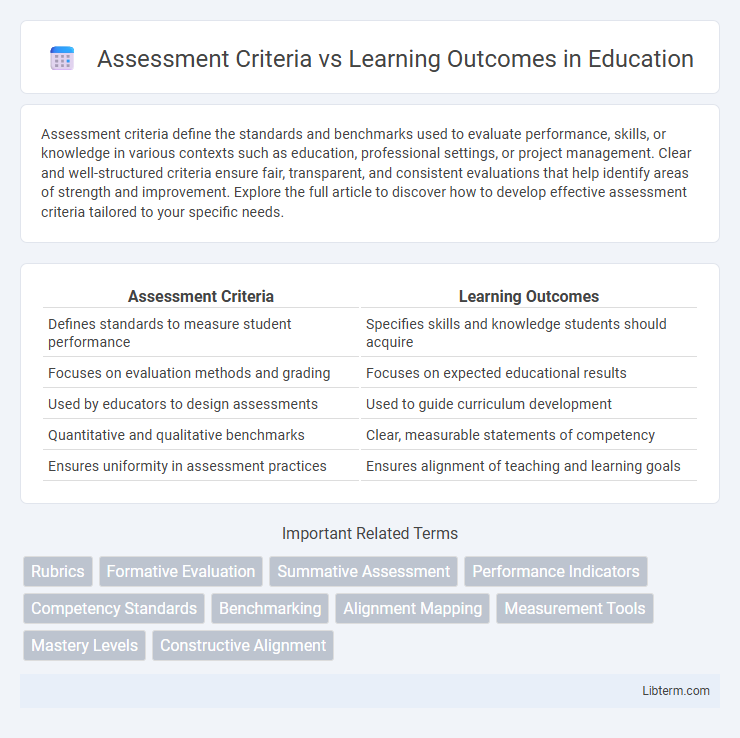Assessment criteria define the standards and benchmarks used to evaluate performance, skills, or knowledge in various contexts such as education, professional settings, or project management. Clear and well-structured criteria ensure fair, transparent, and consistent evaluations that help identify areas of strength and improvement. Explore the full article to discover how to develop effective assessment criteria tailored to your specific needs.
Table of Comparison
| Assessment Criteria | Learning Outcomes |
|---|---|
| Defines standards to measure student performance | Specifies skills and knowledge students should acquire |
| Focuses on evaluation methods and grading | Focuses on expected educational results |
| Used by educators to design assessments | Used to guide curriculum development |
| Quantitative and qualitative benchmarks | Clear, measurable statements of competency |
| Ensures uniformity in assessment practices | Ensures alignment of teaching and learning goals |
Introduction to Assessment Criteria and Learning Outcomes
Assessment criteria define specific standards used to judge student performance on tasks, ensuring transparency and consistency in evaluation. Learning outcomes describe the knowledge, skills, and abilities students are expected to achieve by the end of a course or program. Clear alignment between assessment criteria and learning outcomes is crucial for valid and effective assessment practices in education.
Defining Assessment Criteria
Assessment criteria are specific, measurable standards used to evaluate the extent to which learning outcomes have been achieved by students. These criteria provide clear benchmarks that guide both instructors and learners in understanding the quality and depth of knowledge or skills demonstrated. Well-defined assessment criteria align closely with learning outcomes to ensure consistent, objective, and transparent evaluation processes.
Understanding Learning Outcomes
Learning outcomes define the specific knowledge, skills, and attitudes students should acquire after a learning process, serving as measurable goals that guide both teaching and assessment. Assessment criteria are detailed standards or benchmarks used to evaluate whether students have achieved the learning outcomes effectively. Understanding learning outcomes is crucial for aligning instruction and assessment methods to ensure targeted educational achievements and improve overall student performance.
Key Differences Between Assessment Criteria and Learning Outcomes
Assessment criteria define specific benchmarks used to evaluate students' performance, detailing what evidence is required to demonstrate competence or achievement. Learning outcomes describe the knowledge, skills, and abilities students are expected to acquire by the end of a course or program, focusing on measurable educational goals. The key difference lies in assessment criteria being the standards for judgment, while learning outcomes represent the intended educational targets.
Importance of Clear Learning Outcomes in Education
Clear learning outcomes are essential in education as they provide specific, measurable targets that guide both teaching strategies and student assessments. These outcomes ensure alignment with assessment criteria, enabling transparent evaluation of student performance and academic progress. Precise learning outcomes enhance curriculum design, promote student engagement, and facilitate consistent achievement of educational goals.
Role of Assessment Criteria in Student Evaluation
Assessment criteria provide specific benchmarks that guide the evaluation of student performance by clearly defining what is expected in assignments and exams. These criteria ensure consistent, objective, and transparent grading by aligning student work with predetermined standards and learning objectives. By using assessment criteria, educators can accurately measure the extent to which learning outcomes have been achieved and identify areas for improvement.
Aligning Assessment Criteria with Learning Outcomes
Aligning assessment criteria with learning outcomes ensures that evaluations accurately measure the skills and knowledge students are expected to acquire. Clear, specific assessment criteria derived from learning outcomes enhance the validity and reliability of assessments, guiding both instructors and learners in the educational process. This alignment supports targeted feedback and continuous improvement by directly linking expected performance with measurable results.
Common Challenges in Differentiating Assessment Criteria and Learning Outcomes
Common challenges in differentiating assessment criteria and learning outcomes often stem from unclear or overlapping language that confuses expected performance standards with educational goals. Assessment criteria typically define specific measures for evaluating student work, while learning outcomes describe what students should know or be able to do after instruction. Misalignment between these elements can lead to ineffective assessments that fail to accurately gauge student achievement or instructional effectiveness.
Best Practices for Designing Effective Learning Outcomes and Assessment Criteria
Effective learning outcomes clearly define measurable student capabilities using action verbs aligned with Bloom's Taxonomy, ensuring precise and observable goals. Assessment criteria must directly correspond to these outcomes by specifying standards and performance indicators that gauge the extent of student achievement. Best practices include aligning criteria with outcomes to foster consistency, using rubrics for transparent evaluation, and regularly reviewing both to maintain relevance and clarity in instructional design.
Conclusion: Enhancing Educational Quality through Alignment
Alignment between assessment criteria and learning outcomes is essential for improving educational quality by ensuring evaluations accurately measure the intended skills and knowledge. Clear correlation fosters consistency in teaching, learning, and assessment practices, leading to more reliable and valid student performance data. This strategic alignment supports continuous curriculum improvement and better student achievement tracking.
Assessment Criteria Infographic

 libterm.com
libterm.com